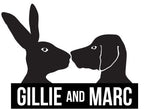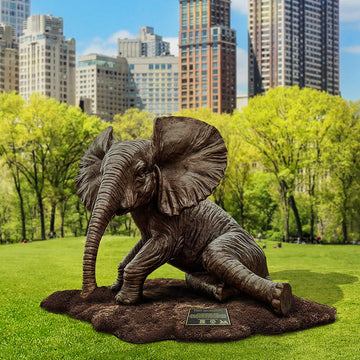Dimensions
Sculpture
59.1 x 76.4 x 61.8 inch (H*L*W) 802.6 lbs
150 x 194 x 157 cm (H*L*W) 364 kgs
Base
7.9 x 82.7 x 63 inch (H*L*W)
20 x 210 x 160 cm (H*L*W)
Medium
Bronze
Style
Contemporary Sculpture, Wildlife, Activist Art
Edition Number
/6
Description
At 4 months old this baby African elephant is very playful. He loves exploring and chasing things and just cannot get enough of the bizarre swingy thing on his face, it’s so much fun! But there is one thing he is very scared of, the people with guns. He had seen one of his aunties being shot down by them. He hadn’t stuck around to see what happened but he had been told they took her tusks then left her there. He couldn’t imagine what he would do if that happened to his mum, how would he survive without her?
The African elephant is the largest land animal in the world and wanders across 37 countries in Africa. There are two subspecies, the Savanna (or bush) elephant and the Forest elephant. Forest elephants are slightly smaller and live in the forests of the Congo Basin. African elephants live in herds led by a matriarch, the biggest and oldest female who looks after her herd and leads them to water holes. Adult males tend to live alone or occasionally join an all-male group.
Elephants have the longest pregnancy of any other mammal, nearly 22 months. Not too surprisingly the baby is huge, weighing 200 pounds at birth and 3 feet tall. Elephants don’t have to worry about being a single parent, they have a system called allomothering. This means that not only the mother but all the young females in the herd will look after the baby. For the first 2 years of their life, the baby will suckle milk from its mother, a whopping 13 litres a day! Babies don’t understand the purpose of their trunk at first. They enjoy swinging it around and even suck it like a human baby would suck their thumb. At about 6-8 months old they learn to use it to eat and drink and once they reach a year old, they can do everything they need, like grasping and bathing. The females will stay with the herd forever while the males will set out on their own at around 12-14 years old.
African elephants are a keystone species meaning they are crucial for their environment. They use their tusks to dig up dry riverbeds in the dry season, digging down to the water hidden underneath and creating water holes for others. They are also important for seed dispersal, eating the seeds of different plants and dropping them all over the place in the form of their poop! The forest elephants also make pathways through the trees for other animals as their great size can power through while happily munching on seeds.
The biggest threat to African elephants is poaching for the ivory trade. 55 elephants are killed a day to fuel the ivory industry and orphaned baby elephants don’t stand much of a chance in the wild without their mothers. Unable to care for themselves and left with psychological scars from the traumatic event, orphaned calves would usually die. Habitat loss is also a major problem. In the last 25 years, the world lost a forested area the size of South Africa. Elephants roam up to 80km a day, so this forces them into dangerous and deadly confrontations with humans when they come into these new settlements, especially when an elephant can eat an entire season of crops in one night! The angry farmers will often kill them in retaliation. Drought that has been seen over much of East Africa in the last ten years is also drying up water holes and diminishing their available food, with plants and trees no longer able to flourish in their changing environment.
Artwork Features
Gillie and Marc love working in bronze for many reasons. Bronze is a very hardy material and will last forever. As experts in coloring bronze, Gillie and Marc enjoy experimenting with their sculptures, adding a splash of color to brighten the work, making it even more unique. > Read more
For every purchase of a bronze sculpture you will receive a certificate of authenticity, titled, signed, dated and editioned by the artists.
Care Instructions
Bronze is very easy to clean, allowing you to enjoy your precious sculpture with minimal upkeep. > Read more
Shipping, Returns and Refunds
Please visit this page to learn all about our policies. > Read more




